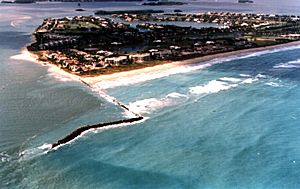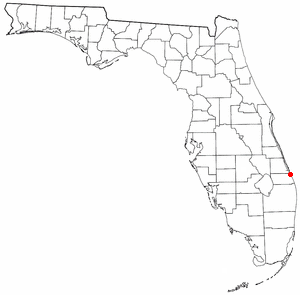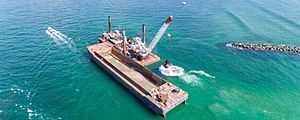St. Lucie Inlet facts for kids
The St. Lucie Inlet, Florida is a special waterway found in Martin County, Florida. It sits between two islands, Hutchinson Island and Jupiter Island. This inlet is one of six openings that connect the Indian River Lagoon to the Atlantic Ocean.
The area around the inlet is full of amazing nature. South of the inlet, you'll find the St. Lucie Inlet State Park. This park is home to beautiful coral reefs, both hard and soft. Just north of the inlet is Bathtub Beach Reef, which is a unique reef made by tiny worms! The beaches along Hutchinson Island are also super important. They are the third most popular nesting spots in the Western Hemisphere for the amazing loggerhead sea turtle.
History of the St. Lucie Inlet
People have known about the St. Lucie Inlet for a very long time. It even showed up on old maps from the 1500s and 1600s, called "Santa Lucia" Inlet. However, these early maps weren't always very accurate.
Later, more detailed maps made in the 1760s and 1770s didn't show an open inlet in this exact spot. But soon after, a natural opening called Gilbert's Bar appeared. This spot became famous because a pirate named Don Pedro Gilbert supposedly used it to escape from bigger ships that were chasing him!
It's important to know that inlets like this often close and open naturally over time. The "Santa Lucia" Inlet that explorer Jonathan Dickinson crossed in 1696 was actually further north. For the last 150 years, the St. Lucie Inlet has been kept open by people using special equipment.
Keeping the Inlet Open: Dredging
Keeping the St. Lucie Inlet open for boats and water flow is a big job. It often requires something called dredging. Dredging means using special machines to dig up sand and mud from the bottom of the waterway. This helps make the channel deeper and wider.
The first time people tried to open the inlet was in 1844. Settlers used picks and shovels to dig! Later, in 1892, a dredge was used to make it deeper. This cost about $2,000 back then. In 1981, a much larger dredging project cost $8 million.
The inlet needs regular dredging because sand naturally builds up, which can make it too shallow or even close it off. This buildup is called "shoaling."
The U.S. Army Corps of Engineers helps manage the dredging projects. They work to keep the main channel deep enough for boats. For example, they aim for a channel that is 16 feet deep and 300 feet wide in some parts.
In 2013, the inlet was dredged again. Sometimes, there isn't enough money set aside by the government for these projects. For example, in 2015 and 2016, no money was requested for dredging.
However, in early 2018, two big dredging projects started. These projects helped clear sand from the inlet and also used that sand to rebuild nearby beaches. This was especially important after Hurricane Irma. The sand helps protect the coast and roads from future storms. Crews moved a lot of sand to make the channel easier for boats to use and to restore the beaches for everyone to enjoy.




